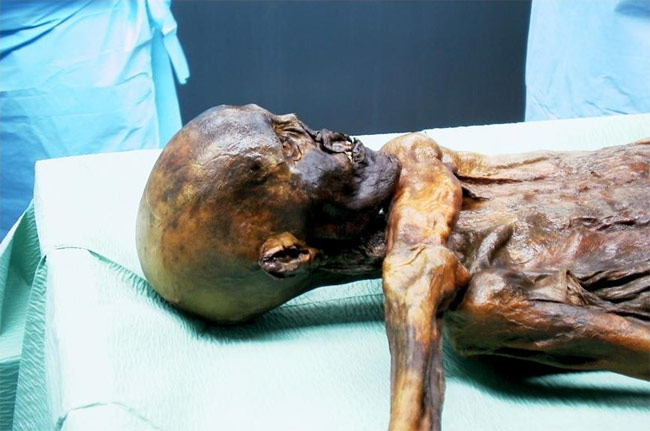Iceman Mummy Had Moss in His Tummy

A new study of the well-known "Iceman" mummy finds that he ate moss, though perhaps not on purpose.
In fact, his gut remains contained six different mosses, a new analysis shows. The unappetizing plants shed light on the Neolithic man's lifestyle and travels during the last few days of his life.
The remains of the Iceman (also called Ötzi, Frozen Fritz and Similaun Man) were discovered accidentally in 1991 by German tourists in the Eastern Alps. Since then, a suite of tests has opened a window into the guy's life and death.
For instance, the Iceman was about 45 years old when he died some 5,200 years ago; he was probably a hunter-gatherer while alive; he sustained a shoulder injury from an arrow and might have died from head trauma; and his last meal included unleavened bread and meat.
Apparently, he also ate and drank some mosses. James Dickson of the University of Glasgow and his colleagues say the moss finding is surprising, because these plants are neither tasty nor nutritious. The mosses were likely accidentally ingested.
In particular, Dickson and his colleagues suggest that one type of moss could have been used to wrap food; another was likely swallowed when the Iceman drank water during the last few days of his life; and yet another would have been used as a wound dressing.
The food-wrapping moss is called Neckera complanata. And the Iceman probably accidentally ingested a moss called Hymenostylium recurvirostrum along with some drinking water before he died.
Get the world’s most fascinating discoveries delivered straight to your inbox.
And he could have applied the bogmoss Sphagnum imbricatum as a wound dressing. That particular bogmoss does not grow, at least today, within about 30 miles (50 km) of the site where Ötzi was found, the researchers say, suggesting the Iceman must have been a traveler.
"The best explanation I can think of is when he was wounded he was in the vicinity of where that particular bogmoss was growing," Dickson told LiveScience.
Researchers in the past have found two wounds on the Iceman, one in the back from an arrow and the other a deep cut in his right palm.
"If he knew of the useful properties of bogmosses, as seems entirely plausible, then he may have gathered some to staunch the wound or wounds," the researchers write in the December issue of the journal Vegetation History and Archaeobotany, "and so tiny pieces could well have stuck to the blood drying on his fingers and then he accidentally ingested some of them when next eating meat or bread as we know he did during his last few days."
Jeanna Bryner is managing editor of Scientific American. Previously she was editor in chief of Live Science and, prior to that, an editor at Scholastic's Science World magazine. Bryner has an English degree from Salisbury University, a master's degree in biogeochemistry and environmental sciences from the University of Maryland and a graduate science journalism degree from New York University. She has worked as a biologist in Florida, where she monitored wetlands and did field surveys for endangered species, including the gorgeous Florida Scrub Jay. She also received an ocean sciences journalism fellowship from the Woods Hole Oceanographic Institution. She is a firm believer that science is for everyone and that just about everything can be viewed through the lens of science.
